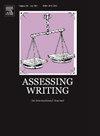Unveiling the precursors of negative emotions in second language writing through control-value theory: An explanatory sequential design approach
IF 4.2
1区 文学
Q1 EDUCATION & EDUCATIONAL RESEARCH
引用次数: 0
Abstract
With the emergence of the psychological focus on second language acquisition, research on second language (L2) writing has gradually transitioned to a comprehensive exploration of the writing process. However, few studies have explored the potential trigger mechanism of negative emotions in L2 writing, especially in learning Chinese as a second language (CSL). To fill this gap, the explanatory sequential design was employed to investigate the relationships among CSL learners’ writing self-efficacy, perceived writing task value, writing anger, and writing boredom based on the control-value theory. The quantitative results illustrate that 1) writing self-efficacy positively predicts perceived writing task value, writing anger, and writing boredom; 2) perceived writing task value negatively predicts writing anger and writing boredom; and 3) perceived writing task value mediates the relationship between writing self-efficacy and writing anger/boredom. The qualitative results add insight to the L2 writing process, revealing that 1) writing self-efficacy exhibited dialectical tension during the writing process; 2) perceived writing task value illustrated contextual immediacy in L2 writing; and 3) writing anger/boredom demonstrated dynamism throughout the procedure of completing the L2 writing task. These results extend the application scope and deepen the theoretical understanding of control-value theory, offering significant pedagogical implications for L2 education.
通过控制价值理论揭示第二语言写作中负面情绪的前兆:一个解释性顺序设计方法
随着心理学对二语习得的关注,对二语写作的研究逐渐过渡到对写作过程的全面探索。然而,很少有研究探讨消极情绪在第二语言写作中的潜在触发机制,特别是在汉语学习中。为了填补这一空白,本研究基于控制价值理论,采用解释序列设计研究了汉语第二语言学习者的写作自我效能感、写作任务价值感知、写作愤怒和写作无聊之间的关系。定量结果表明:1)写作自我效能正向预测写作任务价值、写作愤怒和写作无聊;2)感知写作任务价值负向预测写作愤怒和写作无聊;3)感知写作任务价值在写作自我效能感与写作愤怒/无聊之间起中介作用。定性研究结果进一步揭示了二语写作过程:1)写作自我效能在写作过程中表现出辩证张力;2)感知写作任务价值在二语写作中的语境即时性;3)在完成第二语言写作任务的整个过程中,愤怒/无聊表现出活力。这些研究结果拓展了控制值理论的应用范围,加深了对控制值理论的理论理解,对第二语言教育具有重要的教学意义。
本文章由计算机程序翻译,如有差异,请以英文原文为准。
求助全文
约1分钟内获得全文
求助全文
来源期刊

Assessing Writing
Multiple-
CiteScore
6.00
自引率
17.90%
发文量
67
期刊介绍:
Assessing Writing is a refereed international journal providing a forum for ideas, research and practice on the assessment of written language. Assessing Writing publishes articles, book reviews, conference reports, and academic exchanges concerning writing assessments of all kinds, including traditional (direct and standardised forms of) testing of writing, alternative performance assessments (such as portfolios), workplace sampling and classroom assessment. The journal focuses on all stages of the writing assessment process, including needs evaluation, assessment creation, implementation, and validation, and test development.
 求助内容:
求助内容: 应助结果提醒方式:
应助结果提醒方式:


